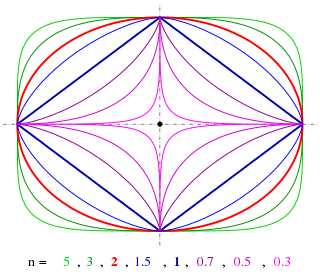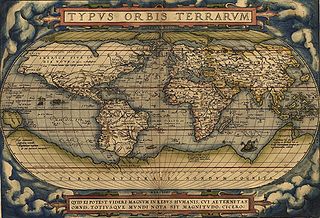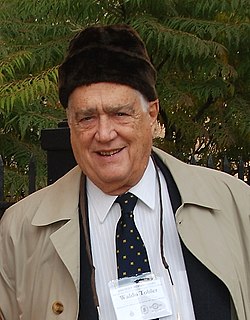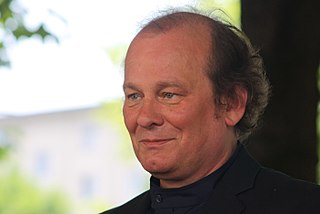
A map projection is a systematic transformation of the latitudes and longitudes of locations from the surface of a sphere or an ellipsoid into locations on a plane. Maps cannot be created without map projections. All map projections necessarily distort the surface in some fashion. Depending on the purpose of the map, some distortions are acceptable and others are not; therefore, different map projections exist in order to preserve some properties of the sphere-like body at the expense of other properties. There is no limit to the number of possible map projections.

A superellipse, also known as a Lamé curve after Gabriel Lamé, is a closed curve resembling the ellipse, retaining the geometric features of semi-major axis and semi-minor axis, and symmetry about them, but a different overall shape.

Johann Heinrich Lambert was a Swiss polymath who made important contributions to the subjects of mathematics, physics, philosophy, astronomy and map projections.
Edward Tufte calls him and William Playfair "The two great inventors of modern graphical designs".

Psychological projection is a defence mechanism in which the human ego defends itself against unconscious impulses or qualities by denying their existence in themselves while attributing them to others. For example, a person who is habitually rude may constantly accuse other people of being rude. It incorporates blame shifting.

Toblerone is a Swiss chocolate bar brand currently owned by US confectionery company Mondelēz International, Inc., which was formerly Kraft Foods, the company that acquired the product from former owner Jacobs Suchard in 1990. It is produced in the capital city of Switzerland, Bern, and the bear symbol of the city is still visible in the logo. Toblerone is known for its distinctive shape, which involves a series of joined triangular prisms.

A world map is a map of most or all of the surface of the Earth. World maps form a distinctive category of maps due to the problem of projection. Maps by necessity distort the presentation of the earth's surface. These distortions reach extremes in a world map. The many ways of projecting the earth reflect diverse technical and aesthetic goals for world maps.
Johannes Liechtenauer was a 14th-century German fencing master who had a great level of influence on the German fencing tradition.

Waldo Rudolph Tobler was an American-Swiss geographer and cartographer. Tobler's idea that "Everything is related to everything else, but near things are more related than distant things" is referred to as the "first law of geography." He has proposed a second law as well: "The phenomenon external to an area of interest affects what goes on inside". Tobler was an active Professor Emeritus at the University of California, Santa Barbara Department of Geography until his death.

The Goode homolosine projection is a pseudocylindrical, equal-area, composite map projection used for world maps. Normally it is presented with multiple interruptions. Its equal-area property makes it useful for presenting spatial distribution of phenomena.

A Lambert conformal conic projection (LCC) is a conic map projection used for aeronautical charts, portions of the State Plane Coordinate System, and many national and regional mapping systems. It is one of seven projections introduced by Johann Heinrich Lambert in his 1772 publication Anmerkungen und Zusätze zur Entwerfung der Land- und Himmelscharten.

The National Front was a far-right political party in Switzerland that flourished during the 1930s. At its peak the group had at most 9,000 members, according to the Historical Dictionary of Switzerland,
and "may have had a membership of 25,000 or so", according to the Simon Wiesenthal Center.
Barry Miles is an English author known for his participation in and writing on the subjects of the 1960s London underground and counterculture. He is the author of numerous books and his work has also regularly appeared in left-wing papers such as The Guardian. In the 1960s, he was co-owner of the Indica Gallery and helped start the independent newspaper International Times.

The two-point equidistant projection is a map projection first described by Hans Maurer in 1919. It is a generalization of the much simpler azimuthal equidistant projection. In this two-point form, two locus points are chosen by the mapmaker to configure the projection. Distances from the two loci to any other point on the map are correct: that is, they scale to the distances of the same points on the sphere.

Garwood Glacier is a glacier occupying the northwest part of Garwood Valley, in Victoria Land, Antarctica. It was first mapped by the British National Antarctic Expedition (1901–04), but was not named until 1911, when Thomas Griffith Taylor of the British Antarctic Expedition, 1910–13, named it for Edmund J. Garwood, professor of geology and mineralogy at the University of London.
Douglas F. Tobler (born c. 1936) is an emeritus professor of German and Holocaust history at Brigham Young University (BYU).

In cartography, the cylindrical equal-area projection is a family of cylindrical, equal-area map projections.

Peter Wawerzinek is a German artist and writer.

In cartography, the loximuthal projection is a map projection introduced by Karl Siemon in 1935, and independently in 1966 by Waldo R. Tobler, who named it. It is characterized by the fact that loxodromes from one chosen central point are shown straight lines, correct in azimuth from the center, and are "true to scale" in the sense that distances measured along such lines are proportional to lengths of the corresponding rhumb lines on the surface of the earth. It is neither an equal-area projection nor conformal.















